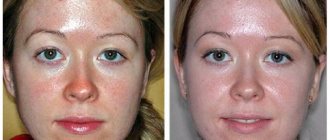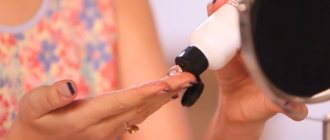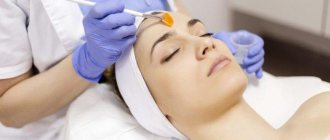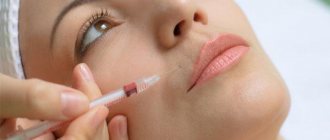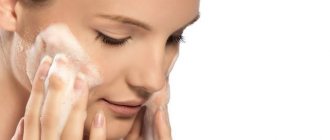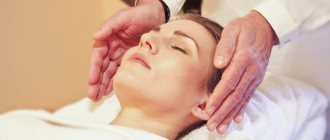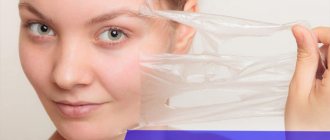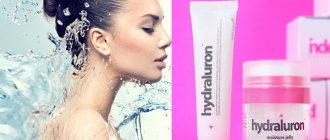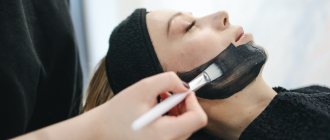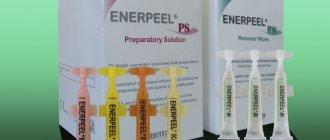Many consider phenol peeling one of the most effective procedures for skin rejuvenation. Others argue that it causes more harm to the body than good due to the toxicity of the drug used.
Before agreeing to such peeling or categorically refusing it, it is worth studying the principle of the action of the main component - carbolic acid.
Properties of phenol
Phenol is called carbolic acid. The substance is volatile and has a strong pungent odor. If it gets on the skin, it causes an immediate reaction. As a result, the active production of glycosaminoglycans and proteins begins, restoring the epithelium and increasing the elasticity of the skin.
Note! Thus, after using phenol, facial skin becomes more elastic, smooth and fresh.
After using phenol, the skin becomes smoother
Despite its beneficial properties, phenol is also considered a toxic substance. When it comes into contact with the skin, it overcomes almost all its layers, penetrating into the body. Over time, phenol components begin to negatively affect brain tissue and are also absorbed into the intestines. As a result, a person may experience seizures, respiratory problems, and bruises. Also one of the side effects is loss of coordination in space. However, the substance does not manifest itself as a carcinogen.
But it is important to note that such problems, as a rule, do not arise, since the procedure does not use pure phenol, but a solution with it, which also contains glycerin, oil and other components.
Note! Despite this, deep phenol peeling is recommended to be done as rarely as possible.
Phenol can cause various side effects, but if used correctly they are unlikely to occur.
Initially, the substance, entering the body, reaches the intestines, where it begins to disintegrate into two components. They are subsequently absorbed by the liver, in which another modification of the substances occurs. As a result, they become harmless and combine with water.
Phenol is excreted from the body through the work of the kidneys. With the help of such disposal, the safety of internal organs from the effects of carbolic acid is ensured. However, the liver and kidneys are not able to cope with large amounts of phenol and remove it in a short time. Therefore, the principle works here: the less, the better.
Thus, given that the organs of the gastrointestinal tract are responsible for the elimination of phenol, it is recommended to undergo examination of the kidneys and liver both before and after the procedure. In addition, it is worth undergoing an additional examination of the heart, since acid can cause problems in the functioning of such an important organ.
Note! To avoid this, the procedure itself is accompanied by cardiac monitoring, which monitors the patient’s heart rate.
Before the procedure, you must undergo an examination
Biochemists Tretman and Helen-Bay proved the existence of a relationship between the amount of carbolic acid administered and its effect on the condition of the human body. Thus, when using this substance, it is worth considering factors such as:
- concentration of phenol in the preparation;
- the area of skin that needs to be treated;
- speed of application of the product to the skin.
Based on the results of the studies, it was found that a small amount of carbolic acid is not capable of causing a strong toxic effect on internal organs and brain function. In addition, if you apply the substance slowly, the liver will have time to process the acid into harmless components and prepare for their elimination. If you treat your facial skin quickly, you can cause a negative reaction from the body to an increase in the amount of substance inside.
A small amount of phenol is not capable of harming the body, especially if it is applied to the skin slowly
Additionally, it is worth considering that the effects of acid can be enhanced by taking certain medications. For example, the liver in the same way neutralizes aspirin and other medications of this kind that penetrate inside.
Note! When peeling and taking medications at the same time, the liver will experience a heavy load and is unlikely to cope with the task efficiently, which can lead to poisoning.
Composition of phenol peels
Phenol peels of the past
A review of publications on the topic of phenol peels reveals a huge variety of different formulas. Phenol was first used as an antiseptic in March 1865 by Lord Lister. At the very beginning of the 20th century, Mankuat, in a scientific work on pharmacology, described in detail phenol as an anesthetic and antiseptic in a concentration of about 5% in an aqueous, oily and alcoholic solution. After which other formulas began to appear in medical publications. This reflects the constant search for the ideal formula and explanation of the mechanisms of action that lie behind the excellent results of phenol peels.
In 1961, Baker and Gordon proposed an original composition in the form of an emulsion for deep peeling, which included 88% phenol, distilled water, septisol and croton oil:
- Croton oil: 3 drops
- Liquid hexachlorophene: 8 drops
- Distilled water: 2 ml
- Phenol 88%: 3 ml
Each component of phenol peeling serves specific purposes: phenol causes keratolysis and protein coagulation due to the destruction of sulfide bonds; Septisol surfactant enhances the penetration of phenol; Croton oil also serves this purpose by causing epidermolysis. The ingredients of the peeling composition are mixed in a clean glass container immediately before the procedure.
After applying the phenol peel, the skin is covered with an adhesive film, which is left in place for 24 hours. Despite the fact that the film increases the penetration of the peeling composition, it also promotes hypopigmentation, as a result of which the skin acquires an “alabaster” color.
Ahronson introduced the glycerol formula of phenol: 88% liquid phenol dissolved in anhydrous glycerol and a few drops of alcohol. This highly concentrated formula, used without occlusion, did not produce an effect as deep as the Baker-Gordon peel when applied.
Ayres achieved a medium peel by mixing phenol and trichloroacetic acid. These two peels are not currently used, as the mid-peel can be performed with other substances, such as TCA, which are potentially non-toxic.
Brown and Kaplan presented a more complex formula of phenol (60% to 95% concentration) mixed with saponin cresol in oil up to 10% concentration. Peeling included test selection of the desired concentration individually for each patient in the parotid area behind the auricle. Peeling was recommended to be applied in zones at 2-hour intervals, so the procedure took 2 days.
McCollough proposed the use of Baker's phenol peel without occlusion, achieving similarly good results, but without the discomfort and side effects associated with this type of peel with occlusion.
Modern phenol peelings
In modern aesthetic medicine, when evaluating new techniques, the safety of the procedure is put first, and then its therapeutic properties, therefore the evolution of phenol peels is moving towards reducing toxicity while maintaining excellent results.
Yoram Fintsi was one of the catalysts for the modern success of phenol peels with his Exoderm formula. According to Fintsy, Exoderm's formula was produced in 1986 and refined in 1990. After this, Fintsy in Israel and Bengamo in France improved the formula. One after another, 3 basic formulas appeared:
#1 liquid phenol, crystallized phenol, distilled water, alcohol, olive oil, sesame oil, glycerol, croton oil, resorcinol, septisol, TCA 30%.
#2 liquid phenol, crystallized phenol, distilled water, alcohol, olive oil, sesame oil, glycerol, croton oil, resorcinol, septisol, salicylic acid, buffer.
#3 liquid phenol, crystallized phenol, distilled water, alcohol, olive oil, sesame oil, glycerol, croton oil, resorcinol, saponins, citric acid, buffer.
The first two formulas use septisol, while the third, which is still used today, uses saponins. The first formula uses TCA, the second contains salicylic acid, and the third uses citric acid. The last two formulas are buffered to stabilize the pH. Fintsi commented on his modern Exoderm formula as a phenol-containing peeling with improved safety properties.
Hetter's formulas are based on simply changing the concentration of croton oil. Thanks to this, there are four formulas: very light, medium light, medium heavy and heavy phenol peeling.
Changing the concentration of croton oil is, in fact, one way to change the strength of phenol peeling, but this is not the only method, and deep phenol peeling can be done without croton oil at all. And you can also change the depth of action of phenol peeling without changing the concentration of croton oil.
The Lip & Eyelid formula by Philippe Depres was first proposed to work safely and without any occlusion on the sensitive skin of the periorbital zone. Then the same formula was used for the perioral area and the entire face, but with occlusion for 24 hours. This is an oil solution of phenol with a concentration of more than 60%. 4 different types of oils are used at different stages of preparing the solution. The purpose of the oily solution is to slow down the penetration of the solution into the skin and prevent maceration of the epidermis and dermis. It also limits the toxicity of phenol due to slower penetration.
Phenol peeling Lip & Eyelid formula for the entire face in combination with botulinum toxin in the forehead, eyebrow area, periorbital area and upper lip. Source: Text-book of Chemical Peels. Superficial, medium and deep peels in cosmetic practice. Philippe Deprez.
Multipeel phenol catalisado is a set for deep peeling, including a preparation for pre-peel preparation for 30 days, the peeling solution itself, which is concentrated phenol (300 mg/g) in combination with lactic (120 mg/g) and salicylic acids (90 mg/g). Then a second layer is applied - a gel, which contains phenol and lactic acid, but in a lower concentration (100 mg/g each component). After the gel has dried, they proceed to applying the third preparation of the Multiped Geloleo system, which is a silicone-based gel, which contains phenol (60 mg/g) and tocopherol (100 mg/g). The task of the third layer is to create a breathable protective layer on the surface of the skin, facilitating the penetration of phenol to the middle section of the reticular layer of the dermis within 48 hours.
Peeling Neopeel Plus and Neopeel Master contain phenol in a lower concentration compared to Multipeel (30 and 50 mg/g, respectively). In addition to phenol, the composition includes lactic acid (40 mg/g), which promotes exfoliation of corneocytes and has a positive effect on the synthesis of ceramides, which are part of the lipid barrier of the stratum corneum.
The formula and concentration of the peeling is selected by the doctor depending on the thickness of the skin, the patient’s phototype, the area of peeling and the type of damage (post-acne scars, photoaging, etc.)
The essence of the procedure
The essence of the procedure is to improve the condition of facial skin. However, in order to achieve this, you should first of all undergo preparation for peeling. To do this, the patient is prescribed a course of medications aimed at avoiding herpetic reactions in the body. This helps strengthen a person's immunity.
The main procedure is carried out in a hospital setting (this is especially necessary for deep peeling). The timing is different for everyone. A session can last from half an hour to two hours - it depends on the condition of the skin and the age of the patient.
This peeling is carried out in stationary conditions.
The algorithm is a sequence of the following actions:
- The patient is given local or general anesthesia.
- A cosmetologist or dermatologist wipes the face with a sponge on which a degreasing agent is applied.
- Additionally, the skin is treated with alcohol.
- A basic solution consisting of two layers is applied. The first layer is phenol itself. The second is a thin silicone film. Finally, the skin is treated with an additional layer of oily gel.
- Peeling is neutralized using a film mask.
- Sunscreen is applied to the face, as the epidermis becomes sensitive to sunlight.
The procedure is carried out in several stages
Area of skin treated and speed of application
The concentration of the substance and its required quantity must be judged based on the area of the skin area in question that is supposed to be treated.
Today, most specialists adhere to superficial phenol peeling. Deep peeling is allowed only in the most extreme cases, when skin problems cannot be solved by superficial ones. In this case, it is worth considering the concentration of the solution used.
Note! If 2% concentration of phenol gets into the skin, the procedure can be fatal.
The most common procedure is superficial phenol peeling.
The rate of application should also be slow so that the liver has time to cope with the processing, and the kidneys have time to remove the toxin from the body. As for the area of skin being treated, it is recommended to use the acid in individual areas, avoiding applying the solution to the entire face.
Individual characteristics of the body
In addition to the main factors, it is also necessary to consider the individual characteristics of the body on the effects of phenol. Special attention should be paid to the functioning of the liver, kidneys and heart, since it is thanks to them that the safe use of the substance can be achieved.
This procedure is not suitable for everyone
Before the procedure, the patient is recommended to undergo a full examination to find out everything about the condition of his body. If the doctor ultimately approves phenol peeling, then you can make an appointment with a cosmetologist.
Impact
If we talk about the cosmetic properties of using carbolic acid, then during phenol peeling the substance has the following effects:
- Exfoliates dead skin cells. The process occurs as a result of the destruction of connections between the horny cells of the epidermis.
- Strengthens capillaries. Compaction of membranes leads to the fact that the walls of blood vessels become stronger, thereby improving their functioning.
Thanks to this procedure, the walls of blood vessels are strengthened - Rejuvenates. As a result of the use of acid, the active production of new cells begins, which leads to skin rejuvenation.
- Eliminates foci of inflammation. Inflammatory mediators are blocked by acid, allowing the condition of the epidermis to improve.
- Kills germs. Thus, various infectious diseases gradually disappear.
- Restores damaged areas. The regenerating effect is associated with the accelerated process of division of new cells.
Phenol peeling helps restore damaged skin areas
Note! To prevent phenol from having a toxic effect on the body, the peeling solution includes additional components, which have already been discussed above. All of them lead to a slowdown in the absorption of the active substance by the skin, allowing the internal organs to cope with the breakdown of phenol and its excretion.
How is the procedure done?
The procedure consists of the following steps:
- Intravenous (for deep effects) or local anesthesia is performed only by an anesthesiologist;
- Makeup removal followed by drying the face (water increases the rate of penetration of phenol into the skin);
- Additional degreasing of the skin with alcohol;
- Applying carbolic acid to the face - do this with smooth strokes; with deep peeling, it is recommended to take a break for five minutes between treating individual areas (during this time the liver has time to neutralize phenol);
- Neutralization of phenol with a special film mask, which is removed only after 48 hours;
- Application of cream with a high level of protection against ultraviolet rays.
The session lasts from 40 to 100 minutes (depending on the depth of exposure to phenol and the individual characteristics of the body). A course of deep and medium peeling consists of one procedure, the effect of which lasts for 5-10 years (superficial peeling is repeated two to three times with an interval of once every 1.5 months).
Video: “Main stages and results of the procedure”
Is phenol toxicity dangerous?
Experts have determined the concentration of phenol, which is not dangerous to the body. The amount of active substance should not exceed 23 mg per 100 ml of blood. Thus, the toxic effects of this substance can only occur when the permissible concentration of acid in the bloodstream is exceeded.
A specific, non-hazardous concentration of phenol must be used
The concentration of phenol entering the blood is determined by the following factors:
- The amount of substance applied to the skin. But it is worth considering that the lower the concentration of the solution, the faster it penetrates into the layers of the epidermis.
- Speed of application. In this case, two speeds are taken into account. The first is how quickly phenol is absorbed through the skin. The second is determined based on how quickly its destruction occurs.
- The area of the skin being treated. The larger the area to which phenol is applied, the more actively it will penetrate the body and enter the blood.
It is better if the product is applied slowly
Thus, if we consider the case of applying a 2% acid solution to the entire face, the result can be sad.
Note! Such an amount of a substance can be fatal, since the blood will have too much acid and the liver will not have time to cope with its breakdown.
What is the essence of the technique?
Phenol peeling destroys old collagen structures
The active ingredient of this peeling is phenol or carbolic acid, which is highly soluble in water and has an alkaline reaction. Phenol is a toxic substance because, when applied to the skin, it can penetrate to the deep dermal layer, causing a burn to the connective fibers of the epidermis. This starts the process of intensive destruction of old collagen structures, which are replaced by new fibers that begin to be actively produced, due to which there is a complete restoration of the inner layers of skin tissue with tightening and smoothing of the surface of the epidermis.
Indications
Phenol peeling is recommended for:
- age-related changes;
- formations of deep wrinkles or folds on the face;
- the appearance of large and noticeable pigment spots;
- presence of scars;
- the occurrence of photoaging;
- deterioration of skin condition (flabbiness, loss of elasticity, appearance of wrinkles);
- acne.
There are certain indications for this type of procedure
In any of the above cases, you can apply for this type of peeling.
What results can you get?
If the procedure has a favorable outcome without consequences or complications, the patient can expect to receive the following results:
- noticeable rejuvenation of facial skin;
- general improvement in the condition of the skin structure;
- complete elimination of pigmentation;
- getting rid of scars, scars, deep wrinkles;
- normalization of all processes occurring in the skin tissue;
- increasing the overall tone of the epidermis;
- restoration of firmness and elasticity of the skin.
Contraindications
It is not recommended to resort to peeling if:
- the patient's age is less than 18 years;
- at the time of testing, the patient is pregnant or breastfeeding;
- there are burns on the skin;
- there are diseases associated with the performance of internal organs;
- there is hypersensitivity to any of the components of the solution;
- at the time of treatment the woman is menstruating;
- a mental disorder was discovered;
- infectious diseases have been identified.
This procedure has many contraindications.
Note! Also, peeling should not be performed on older people over 60 years of age.
Contraindications and risks
As mentioned above, deep exfoliation with carbolic acid is very toxic and therefore carries greater risks than other types of peeling.
Firstly, the likelihood of scars appearing sharply after tissue healing. It is also possible for the dermis to recover for a long time, hyperpigmentation to develop, or white spots to appear.
Secondly, phenol has a cardiotoxic effect, which increases in direct proportion to the simultaneously treated area.
It is equally important to identify concomitant pathologies, since many of them can worsen under the influence of carbolic acid.
In addition, contraindications to peeling are:
- disruption of the cardiovascular system;
- renal failure;
- liver diseases;
- pregnancy and lactation;
- cancerous tumors;
- herpes in the acute stage;
- hypersensitivity to acid enzyme ingredients.
A conditional contraindication to deep exfoliation may be age after 60 years. During this period, as a rule, a sufficient number of diseases accumulate that do not allow complete exfoliation and significantly reduce the rate of tissue regeneration, so the recovery period can drag on for 3–4 years.
Advantages and disadvantages
Among the pronounced advantages of phenol peeling are:
- control over the amount of composition used;
- high-quality results that can be seen almost immediately;
- long-term preservation of the result. The effect can last from two to ten years;
- one-time peeling.
The effect of the procedure lasts for a long time
However, this type of peeling also has disadvantages. Among them:
- a long list of contraindications;
- the need for a full medical examination;
- long period of rehabilitation;
- painful procedure;
- toxicity of the active component, causing a possible risk of complications;
- a long and responsible preparation process.
This procedure may be painful
As for the last point, it is worth considering in more detail.
List of possible complications
Each patient should be warned about the possible occurrence of complications such as:
- prolonged redness of the skin (erythema), which can persist for 2 to 3 months. This condition can be caused by the use of high concentrations of phenol;
- the appearance of infectious skin lesions caused by the penetration of streptococcus, staphylococcus or Pseudomonas aeruginosa;
- ectopia of the lower eyelid, in which the skin is pulled down;
- loss of pigmentation, depending on the skin type and physiological characteristics of the patient’s body;
- scars in the area around the eyes, caused in most cases by improper skin care during the rehabilitation period.
Preparation process
The sequence of actions in this case is as follows:
- Complete medical examination of some internal organs. These include the heart, liver and kidneys.
- Treatment of leather with special means. The course of treatment should last for a week.
- Taking antioxidants for two to three weeks.
- Stop taking retinoids six months before the procedure.
- Avoid epilation, shaving or mechanical cleaning two weeks before peeling.
- Refusal to perform laser operations six months before the procedure.
- Identification of possible allergic reactions and subsequent notification of them to a cosmetologist or dermatologist.
- Taking medications that help strengthen the body's immunity.
It is important to prepare thoroughly before the procedure
Note! It is also recommended to avoid walking in the sun and artificial tanning.
PROTOCOL
Phenol facial peeling causes pain, so it is performed under anesthesia. If we are talking about deep cleaning, it is carried out under general anesthesia.
Cosmetologists recommend using this peeling to cleanse the most problematic areas first, rather than the entire face - this will help reduce the toxic effects of phenol.
- Immediately before the session, the skin is cleaned with a soap solution, and then disinfected with alcohol and treated with an anesthetic (usually lidocaine). In the case of deep peeling, anesthesia is administered intravenously.
- Then a peeling composition is applied to the face, and this process should be slow, with breaks between treating different areas of the skin.
- At the next stage, a film mask is applied to the face, which neutralizes the acid, and then a sunscreen.
We recommend: DEEP FACIAL PEELING: with your daughter like sisters
The duration of the procedure , as a rule, does not exceed 2 hours.
Pre-peeling preparation
- 6 months before phenol exfoliation, you should stop taking retinoids and laser peels.
- For 10-14 days, it is necessary to exclude mechanical cleaning and epilation of the treated area.
- for 2 weeks before peeling, and for a week - antiherpetic drugs, which are selected after consultation with a specialist.
In addition, you need to stop visiting the solarium for 3 months
It is recommended to use whitening cosmetics.
Price
The price of 1 session varies from 40€ to 350€.
It is worth considering that we are talking only about phenol exfoliation itself.
Additional costs will be required for medications to prepare for the session and recovery.
In the case of deep phenol peeling, you also need to pay for anesthesia and hospital stay.
Rehabilitation
At the end of the procedure, the patient will experience a strong burning sensation and pain in the facial skin, so the doctor may prescribe painkillers, which are recommended to be taken for several days.
As for the rehabilitation period itself, during the first day it is necessary to avoid contact with water and exposure to sunlight. The fact is that after peeling, the face is an open wound, so any such contact with water or the sun can lead to complications.
During the first day, you should avoid contact with water.
On the second day, you can remove the film mask. Along with it, dead cells will be removed, cleansing the skin of the stratum corneum. At the same time, do not be afraid of the purple color of renewed skin. Over time, it will acquire a light shade and a healthy appearance. During this time, it is also recommended to avoid contact with water.
Already on the third day, a tightening crust will begin to form. You cannot rip it off, as you can leave scars on the healing skin. It is best to use Panthenol to remove the crust.
You can’t rip the crust off your face
Note! At the end of the second week, we can talk about complete restoration of the epidermis. After this, the person can go out again. However, the final result and improvement in skin condition will occur only a year after the procedure.
At this time, cosmetologists recommend:
- refuse to visit beaches and solariums;
- use whitening products to restore complexion;
- apply moisturizers and sunscreens;
- start taking antioxidants and vitamins.
The skin will recover in about two weeks
If you follow the recommendations, the rehabilitation period will be significantly reduced.
RECOVERY PERIOD
After cleaning, pain and burning sensations appear, so it is worth stocking up on painkillers.
During the day, you should not allow even the slightest contact of your skin with water. Experts recommend not even brushing your teeth.
Remove the mask only on the second day after peeling. Along with the film, the upper layer of the epidermis will also separate, and over time the skin begins to peel off.
It is impossible to pick off the crusts that form after phenol peeling, so the use of scrubs and other exfoliating agents is prohibited.
We recommend: AHA PEELING, or WHY CLEOPATRA TOOK MILK BATHS
To prevent infections after cleaning with phenol, you need to treat the skin with panthenol-based preparations (in the form of a spray).
As a rule, after superficial cleaning, peeling goes away after 2 weeks . But this does not mean that the skin has completely recovered.
Redness may persist for several months, and during this period it is recommended to continue using panthenol.
You can use decorative cosmetics only after 3 weeks , and sunbathe only after 1 year .
Cosmetologists advise using powerful sunscreens, whitening agents, antioxidants and moisturizing complexes, which include hyaluronic acid.
Such products will help protect the delicate dermis after treatment from sun rays and hyperpigmentation, as well as speed up the healing process.
Side effects
The following side effects may occur during the procedure:
- arrhythmia;
- renal failure;
- burns of various degrees;
- deterioration of the immune system;
- the occurrence of viral diseases;
- allergy;
- formation of scars, age spots;
- pain, which also includes burning and itching;
- swelling;
- pore expansion.
Possible side effects
Note! In case of any complications, you should contact the cosmetologist who performed the procedure, as well as a therapist.
Precautionary measures
An important point in phenol-based cleaning is a thorough analysis of the patient’s condition in order to identify contraindications.
Here it is worth considering the fact that this procedure is indicated for the age category of people.
The session is carried out in the operating room under the supervision of a doctor, using a dropper and careful monitoring of breathing and heart rhythm.
Exposure to the chemical is prohibited in the neck area due to the high risk of scarring. As a result, a clear demarcation line is formed, which can be eliminated through glycolic peels and lifting care.
Features of peeling
The key feature of this type of peeling is that it is only possible in a hospital setting. This procedure cannot be carried out at home, at least due to the lack of necessary equipment and solutions.
This procedure cannot be carried out at home.
Skin recovery will take two to three weeks, and during this time swelling is possible. A crust begins to form on the third day and peels off in the third week.
Note! Skin color can change within six months.
What effect to expect
Carbolic peeling guarantees high results very quickly. It has a beneficial effect on the functioning of skin cells and stimulates internal processes, including collagen production. Reviews from patients confirm the wonderful transformation of the skin after phenol peeling.
After the peeling procedure, the following changes occur in the skin:
- The rate of cell regeneration accelerates;
- The elasticity and firmness of the fibers of the skin are restored;
- The cells begin to actively function;
- Pigment spots disappear;
- The skin tone is evened out, they look fresher and younger;
- The relief of the face is smoothed out, small and medium wrinkles, scars and post-acne completely disappear;
- The contours become clear and toned;
- A pronounced lifting effect is observed.
It is difficult, but realistic, to believe in such a wide range of effects of phenol. A high result and restored youth justifies the complexity of the procedure, its toxicity and danger.
Rules for the procedure
When performing peeling using carbolic acid, you should follow the following rules:
- Throughout the procedure, the patient must be connected to a device that monitors the heart rhythm. In this way, the doctor has the opportunity to notice problems in the heartbeat in time and stop the procedure. It is worth noting in advance that this type of peeling is contraindicated for those who have problems with the heart and kidneys.
- Before starting peeling, the doctor should give the patient a drink that can cause a decrease in the concentration of phenol absorbed by the skin. Also, during the procedure, the patient is given additional glucose.
- To avoid pain, local anesthesia is required.
During the procedure, a machine is connected to the patient that allows you to monitor your heart rhythm.
The area of the treated areas should not exceed 25% of the face area. Between treatment of several zones take breaks of 15 minutes.
When the procedure is not recommended
To prevent complications and health problems, carefully read the following list of contraindications:
- period of pregnancy and lactation;
- pathologies of the heart and blood vessels;
- renal and liver failure;
- open wounds and damage to the integrity of the epidermis;
- exacerbation of the herpes virus;
- individual intolerance to phenol;
- genetic predisposition to the appearance of keloid scars;
- age up to 40 years;
- taking medications containing aspirin;
- diabetes;
- thyroid dysfunction;
- fungal infections;
- elevated body temperature and colds.
FAQ
Is it possible to carry out phenol peeling at home?
Doctors prohibit carrying out such a procedure at home. Phenol peeling can only be performed by a qualified doctor or cosmetologist who can organize hospital conditions. In addition, all precautions must be observed throughout the procedure.
How long does the effect last and when is it shown?
The main advantage of this procedure is that the effect lasts quite a long time. Doctors usually recommend resorting to phenol peeling after 40 years, when deep wrinkles and other signs of active aging are already visible.
It is better to resort to this procedure after 40 years
Many photographs taken after peeling are repulsive. Is it worth resorting to such a procedure?
Photos after peeling show a crust formed, which will disappear over time. This is a completely normal phenomenon, which you can get rid of after two weeks. Therefore, do not be afraid of such results.
Is phenol peeling painful?
Yes, the procedure is painful. But during this procedure, doctors administer local anesthesia or use general anesthesia.
To ensure that the patient does not experience discomfort, local anesthesia is given.
How is peeling different from surgery?
If we talk about a surgical operation, then such an intervention drapes the facial tissues, moving them. As a result, the configuration of the skin changes, but its appearance does not change. Peeling, in turn, completely removes dead cells, which leads to a rejuvenating effect.
Is it possible to combine the procedure with others? And with which ones, if so?
Yes, if you take into account time periods. For example, you can resort to facial plastic surgery if several weeks have passed since the procedure.
You can also combine peeling with biorevitalization. The latter means the injection of preparations containing hyaluronic acid into the patient’s skin. As a result, the functioning of fibroblasts improves, and the duration of the peeling effect increases. True, biorevitalization will have to be done 3-4 weeks after the session.
Phenol peeling can be combined with some other procedures
Finally, peeling can be combined with Botox or Dysport, which are also used as injections.
Post-peeling skin care
After completing the procedure, the patient feels a burning sensation in the treated areas. If the pain after phenol peeling cannot be tolerated, you can use painkillers.
On the first day after the procedure, you should avoid getting liquid on the skin, because water enhances the penetration of phenol and can lead to skin burns. You should drink water through a straw and avoid brushing your teeth.
The mask is removed 2 days after the procedure along with dead skin particles, revealing bright red renewed young skin.
A superficial tightening crust begins to form starting from 2 days. During this period, the use of panthenol spray is prescribed. Under no circumstances should crusts be removed forcibly; this can lead to scarring.
Full recovery occurs on average within 10-14 days. The full process of skin maturation is completed in approximately 7-12 months. Painful sensations and redness of the skin disappear on average after 2 months. During this entire time, it is recommended to use panthenol spray.
The following are prescribed as post-peeling care:
- vitamins A and C;
- sunscreens with SPF 50+;
- antioxidants;
- bleaching agents;
- moisturizing complexes based on hyaluronic acid.
Reviews
Marina, Ekaterinburg
“You want to look good at any age, and that’s why I decided to undergo a phenol peeling procedure. The cosmetologist sent me for a short examination, after which I was allowed to use this procedure. As for the effect, after the rehabilitation period, the condition of the skin noticeably improved: it became smoother, pigmentation disappeared.”
Olga, Orenburg
“My job forces me to be around people almost constantly, so I simply have to take care of my appearance. The face is no exception, and recently I decided to take the advice of a cosmetologist who suggested that I undergo a phenol peeling procedure. During the session, I was given a painkiller, but I still felt discomfort. However, it is clearly worth it, as over time my skin became smoother and wrinkles disappeared. In general, I’m happy with the result!”
Patients note that although such peeling has a rather aggressive effect on the skin, the effect is excellent.
Yaroslava, Orel
“Even when I was young, I had a problem with acne. Over time, of course, it went away, but the scars remained, and it tormented me greatly. A friend advised me to use a procedure called phenol peeling, and I decided to try it. Moreover, no medications have ever coped with this problem. When visiting a cosmetologist, I was recommended a gentle peeling, since I was still quite young. But even after this procedure, the skin condition became noticeably better and the scars finally disappeared. The rehabilitation period lasts, of course, quite a long time, but the result is simply excellent.”
Indications for use
Phenol peels are the most radical type of skin cleansing and rejuvenation, which does not require surgical intervention, but is performed by exposing the epidermis to a chemical composition. To carry out the phenol procedure, it is important to have the following indications:
- Disadvantages of facial relief (deep expression and age wrinkles, stretch marks, scars after surgery);
- Rapid withering of the skin, loss of turgor and tone;
- Symptoms of photoaging of the skin;
- Hyperpigmentation on the face, residual marks after sunburn;
- Consequences of acne, demodicosis;
- A number of dermatological diseases (certain types of keratosis).
Phenol peeling is a confident step to restore the youth of your face. Rest assured, you will experience renewed skin that is soft and supple. The face becomes perfectly smooth and toned, just like 10 years ago. At the same time, the active synthesis of your own collagen and elastin is launched, so the result lasts for another ten years.
Photos before and after the procedure
Photos before and after superficial phenol peeling No. 1
Photos before and after superficial phenol peeling No. 2
Photos before and after medium phenol peeling No. 1
Photos before and after medium phenol peeling No. 2
Photos before and after deep phenol peeling No. 1
Photos before and after deep phenol peeling No. 2
What is this procedure
Phenol facial peeling is the most effective method of chemical skin cleansing. The procedure boasts not only high achievements in facial transformation, getting rid of deep wrinkles and scars, confident resistance to age-related changes, but also the sustainability of the effect for 5–10 years.
The essence of the phenol procedure is to cauterize problem areas of the epidermis with phenol. This causes the removal of dead cells, smoothing the relief of the skin and its active regeneration over the entire surface.
A little history: phenol or carbolic acid, as a chemical compound, became known to humanity back in 1863. It began to be used in medicine, as an excellent disinfectant and acne fighter. It was only in the 90s that carbolic acid began to be used for facial peeling. In recent years, phenol peeling has increased its popularity tenfold and has earned the honorary title of “gold standard” among cosmetologists.
Facial peeling with phenol is a dangerous and painful procedure, but at the same time highly effective and with lasting results. The opinions of cosmetologists about the possibility of the existence of phenol peeling as a cosmetic procedure categorically differ. Some cosmetologists demand that we stop using phenol on the skin, while others, on the contrary, insist on its importance in the fight against aging and age-related problems.
Surprisingly, both sides are right. It has been proven that phenol can lead to the death of a patient if its dose in the blood exceeds 0.23 mg/ml; in smaller amounts the substance can cause arrhythmia.
To justify phenol peeling, I would like to note that the procedure uses products with a minimal content of toxic components, so the procedure cannot lead to death. In addition, a cosmetic composition with phenol is applied slowly to prevent the accumulation of a potent substance in the blood. Positive reviews from patients and cosmetologists prove that up to 10 years after cleansing, the skin is elastic, toned and looks young, like after plastic surgery.
Phenolic peeling is performed with a special product. The main active ingredient (exfoliant) is phenol. The concentration of phenolic acid varies from 3 to 35%, depending on the extent of the epidermal problem that needs to be corrected. To accelerate the absorption of phenol by the skin, oil is added to the composition. Liquid glycerin, propylene glycol and distilled water are used as additional components of the peeling product.
There are 3 types of phenol peeling:
- Mid-superficial phenol peeling – the procedure uses a minimum concentration of phenol (3%);
- Medium phenol peeling - the concentration of carbolic acid is increased to 25%;
- Deep phenol peeling - such cleansing is performed extremely rarely. The peeling product contains 35% phenol. The procedure is performed only after a thorough medical examination of the patient’s condition.
Facial peeling with phenol is very painful and is only performed under general anesthesia. Be sure to inform your cosmetologist if you are allergic to certain drugs used for anesthesia or peeling.
Cost of the procedure
Let us give the approximate price of a phenol peeling procedure in different cities of Russia. It is worth noting that the cost, in addition to the substance itself, includes hospital stay, the use of anesthesia, and the work of a doctor.
| City | Cost of one procedure |
| Moscow | 15000 rub. |
| Saint Petersburg | 12000 rub. |
| Ekaterinburg | 13400 rub. |
| Nizhny Novgorod | 12600 rub. |
| Belgorod | 11700 rub. |
| Rostov-on-Don | 10600 rub. |
| Vladivostok | 12900 rub. |
Expert opinions
Experts agree that chemical peels have a beneficial effect on facial skin when done by professionals. A person should take into account his individual characteristics and consult a cosmetologist before phenol peeling procedures. It is important to prevent the occurrence of adverse reactions and complications, and this requires both the professionalism of the cosmetologist and the trust of the client. A cosmetologist must know about all predispositions and allergic reactions in order to prevent their manifestation. If everything is in order, then phenol peeling has a very effective effect on the regenerative capabilities of the skin, thereby causing a rejuvenation effect.
Other experts believe that frequent use of phenol peeling, like any other, can lead to depletion of the regenerative resources of epidermal cells and collagen synthesis. They believe that in this way the number of cell regeneration cycles genetically inherent in each person can be very quickly used up, which will lead to rapid aging in the future.
It is not for nothing that phenol peeling is very popular in anti-aging cosmetology. It really restores youth and healthy radiance to the skin, also eliminating cosmetic defects. It is important to know when to stop and not take risks if there are contraindications.
Tell us in the comments your opinion about phenol peeling if you have already used it. Bookmark this article if you found it useful and interesting. Share it with your friends on social networks.
Let's sum it up
Phenol peeling is a procedure that is very different from “standard” similar methods of influence. It is recommended to eliminate pronounced skin defects: post-acne, burn marks, scars or cicatrices. Of course, phenol peeling will also help get rid of wrinkles. But do not forget about the features of this method, its contraindications and side effects, as well as the rules of preparation. Be sure to first consult with a therapist, dermatologist and cosmetologist.
Types of peeling
Ready-made preparations for the procedure are rare, so practitioners mix the ingredients themselves. Includes:
- carbolic acid;
- glycerol;
- essential oils (promote greater absorption of the active substance);
- distilled water.
Citric or lactic acid may also be added to balance the pH.
There are several modifications of phenol peeling, they differ in the level of concentration and degree of penetration.
- Superficial . Presented with carbolic acid in a ratio of 3%. Designed to eliminate pigmentation, scars, scars and post-acne, as well as to treat acne and smooth out facial wrinkles. One of these is the drug Danne.
- Middle . The concentration of the active component is 25%. Helps get rid of acne and whiten skin. Can be used to easily smooth out skin texture and eliminate moderate wrinkles. As an alternative, you can use a TCA peel based on trichloroacetic acid.
- Deep . The concentration of the active component is 33%. Recommended exclusively for use on sagging and heavily wrinkled skin with obvious signs of age-related pigmentation.
Deep facial peeling procedure
The phenol cleaning process lasts about three hours.
Throughout the entire session, the doctor must monitor the patient’s condition, and if any pronounced reactions appear, for example, bright redness, then the procedure is stopped immediately.
After such a serious cleansing, you need to take pain relief for the first couple of days. These days you can’t wash your face, even brush your teeth, and getting water on your face is unacceptable. Within a week, maybe up to 10 days, a film will peel off from the skin of the face, the face will resemble the skin of a baby with redness. The final restoration of facial skin will last up to 6 months.
Phenol peeling is a fairly expensive procedure, and recovery after it is also not a cheap pleasure. But it's worth it, especially if you want to regain your youth.
Superficial, medium and deep chemical peeling
There are 3 types of chemical peeling based on the depth of impact:
Superficial chemical peeling
The most gentle superficial peeling is done using
- alphahydroxy acids (abbreviated as AHA peeling ). The second name for these acids: fruit , since they are mainly obtained from fruits: apples, wine, lemon. Mandelic, lactic, glycolic acid (from sugar cane) and others are also used for surface peeling.
- enzymes , the second name of which is enzymes. Therefore, such peeling is often called enzyme peeling .
Superficial chemical peeling
- improves skin texture;
- fights fine lines and wrinkles;
- restores skin tone.
There is virtually no pain during superficial peeling; there is no swelling, pinpoint hemorrhages or other problems typical of other types of chemical peeling. After chemical peeling, no rehabilitation period is required - skin restoration after this procedure occurs quite quickly.
It is superficial chemical peeling that can be safely carried out at home . Read more about this in the section “Chemical peeling at home.”
To enhance the effect of peeling, AHA acids can be used in conjunction with others: salicylic, retinol, ascorbic and others. In addition, antioxidants, whitening and other beneficial substances are added to the recipe.
You can buy combined glycolic chemical peeling in our online store.
Medium chemical peel
Peeling with trichloroacetic acid
Medium peeling is performed with trichloroacetic acid. This is the main method to combat
- wrinkles;
- scars and scars;
- stretch marks;
- skin changes after acne;
- superficial pigmentation.
Medium peeling is quite traumatic.
After applying trichloroacetic acid to the skin, the treated area gradually turns white - a frost effect. This indicates protein denaturation and the formation of a film that prevents further penetration of acid to avoid the appearance of scar changes. The acid exposure time depends on the skin type. For sensitive skin, the frost effect appears within 1-2 minutes. For medium skin it will take 4-5 minutes, for thick and oily skin – 8-10 minutes.
For 3-4 days after the procedure, swelling persists, a crust forms, which begins to peel off by the 4th day. The skin is completely cleared around the 7th day. The duration of the full rehabilitation period after chemical peeling is about a month.
To achieve greater effect, medium chemical peeling can be repeated after 1-2 months. To maintain the effect, one medium peeling procedure once every 1-2 years is enough.
Salicylic chemical peel
Medium peeling also includes chemical peeling based on salicylic acid.
This procedure causes quite severe peeling and produces a good anti-inflammatory and antiseptic effect.
Salicylic peeling practically does not produce an irritating effect and cannot penetrate into the deep layers of the skin. This property significantly reduces the possibility of post-peeling side effects.
Indications for the use of salicylic peeling:
- acne, acne (since salicylic acid has antiseptic and anti-inflammatory properties);
- increased skin oiliness;
- enlarged pores;
- acne scars;
- hyperpigmentation.
You can buy salicylic peeling in our online store.
Deep chemical peeling
For deep peeling, phenol (carbolic acid) is used. Phenol peeling is considered a fairly radical method of affecting the skin. It must be carried out by a qualified specialist in a hospital setting. An anesthesiologist and a resuscitator are always present during the operation.
Indications for the use of deep chemical peeling:
- stretch marks;
- old scars;
- skin changes after acne;
- age-related skin changes.
The procedure uses phenol enclosed in a special shell (liposome). Gradually released from it, the composition acts evenly on the skin, reaching the deepest layers, “dissolving” wrinkles and giving the skin a pronounced lifting effect.
Irritation lasts for 5-7 days. In this case, the skin requires special care - gel or vaseline coating. The inflammation disappears after 4-6 days. Complete skin restoration occurs after 6 months.
In preparation for the procedure and after peeling, a course of antiherpes drugs and antibiotics is prescribed.
Peeling
Doctors strictly follow the instructions for treating the skin with phenolic and auxiliary substances to minimize the risk of serious damage. The manipulation is carried out only in a hospital; it is strictly prohibited to do it at home; it can be dangerous to health and life.
The whole process consists of the following stages:
- Local anesthesia is administered or general anesthesia is given.
- The face is cleaned with a hard sponge dipped in soapy water.
- For degreasing, a 70% alcohol solution is applied.
- Carbolic acid is applied to problem areas using a cotton swab. Then a silicone mask, and after that an oil gel. Excipients can increase the effectiveness of the procedure and reduce the aggressive effect of phenol.
- And at the very end, the face is covered with a “Jeleo” wax mask; it guarantees an even distribution of the acidic product and neutralizes it.
- The mask along with the keratinized layer of skin is removed after 48 hours. Wounded tissues are treated with antiseptic drugs and then moisturized. The last step is to apply a sunscreen with the highest SPF level.
Mimic activity is limited as much as possible. You need to drink and eat through a straw so that liquid does not get on your face, as it reacts with phenol and can cause a burn.
Indications, contraindications
This procedure differs from other chemical peels in that it is essentially a last resort, that is, it is used in cases where the client’s age is no longer suitable for more gentle procedures (over 40 years old) or there are contraindications for other types of deep effects, for example, laser resurfacing.
Thus, serious age-related changes that cannot be eliminated in any other way can be considered indications for phenol peeling, namely:
- pronounced wrinkles;
- strong pigmentation;
- sagging skin;
- the presence of obvious scars, including post-operative scars;
- other defects that spoil the appearance of the skin.
Once in the body, carbolic acid is excreted through the kidneys and liver, poisoning them. But in small doses, these organs are able to neutralize the negative effects, but this will only happen when they are fully operational. That is why before carrying out phenol peeling it is necessary to undergo a complete examination of the body.
The reason why phenol peels, despite being such a risky and complex procedure, still remain popular today is because of the amazing results. Very rarely, women are dissatisfied with the peeling performed. In other cases, a pronounced lifting effect, getting rid of pigmentation and a network of wrinkles are especially noted.This determines the presence of an extensive list of contraindications, including:
You can also read: Types of peelings
- various chronic diseases of the liver and kidneys;
- problems related to the nervous system;
- malfunction of the thyroid gland;
- age up to 18 years (in practice, as already mentioned, such a procedure is carried out only in adulthood, the number of exceptions is very small);
- a large number of moles on the face;
- diabetes;
- pregnancy and lactation;
- oncological diseases;
- individual intolerance to peeling components and much more.
In this case, a consultation with a doctor is mandatory, since only a complete picture of your health condition will help you draw a conclusion about the admissibility of peeling with carbolic acid.
At the same time, one should also take into account the fact that the time period during which such peeling can be done has not only a lower limit (35–40 years), but also an upper limit (60–65 years), since the ability of the liver to remove harmful substances from the body.
Peeling review
Valentina:
“I started thinking about phenol peeling when deep wrinkles and signs of skin aging appeared. Before this, homemade peelings and cosmetics were available, but the moment came when it was necessary to choose. Since plastic surgery was not justified for me, I chose peeling. All my friends have already undergone this procedure and recommended a specialist who does a good job.
After the procedure, I came to my senses for several days. Swelling and pain appeared, but everyone insisted that this was temporary and a normal reaction to the procedure. She took medications to relieve pain.
And over time, after about a week, the skin began to return to normal. All the effects of the peeling went away after a few weeks, and the mask was completely removed, the crust fell off, and after a while the redness went away. And when I saw the result, I realized that all the torment was worth the effect. Pigment spots and wrinkles disappeared, the skin became young and soft. This is exactly the effect I expected.”
